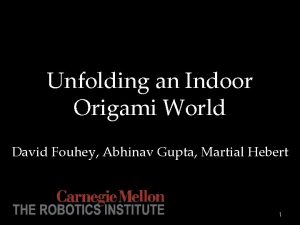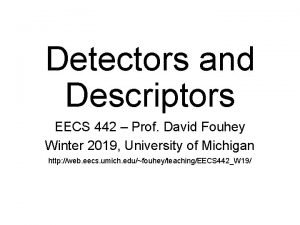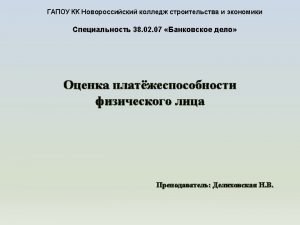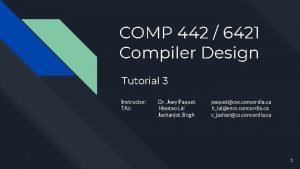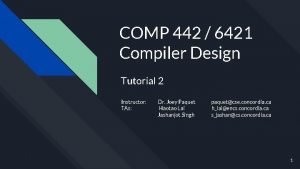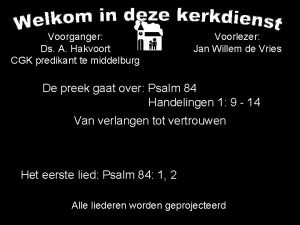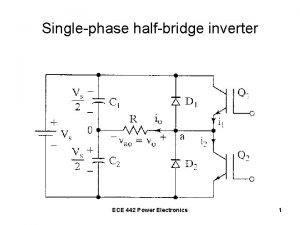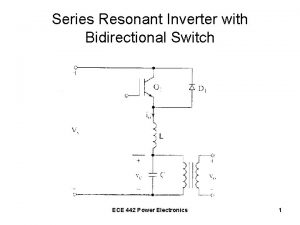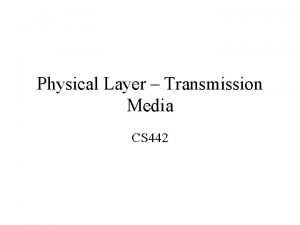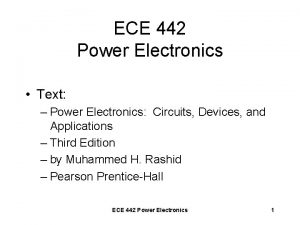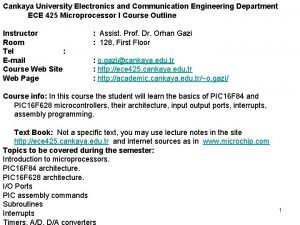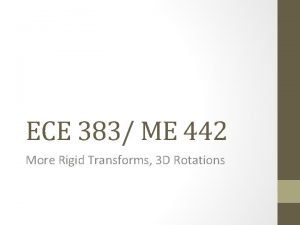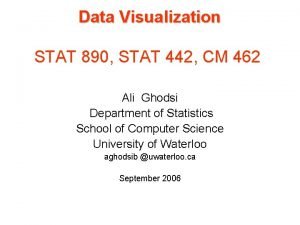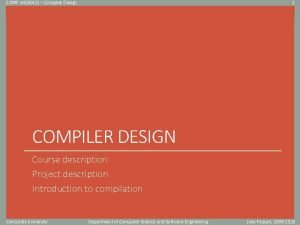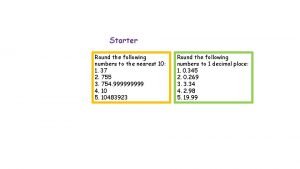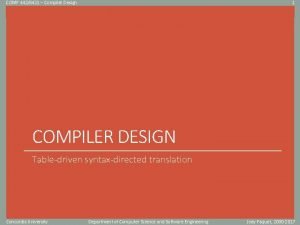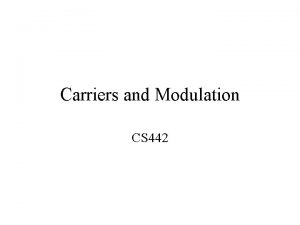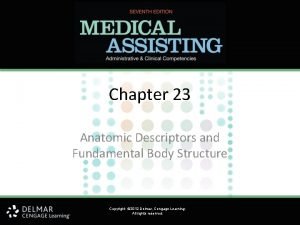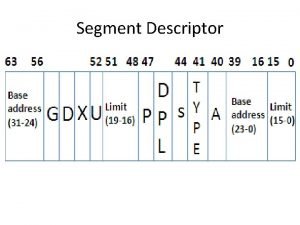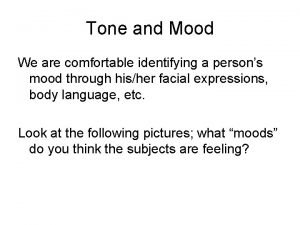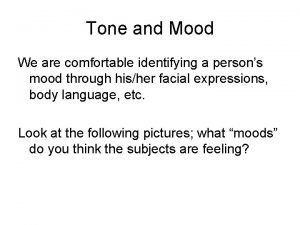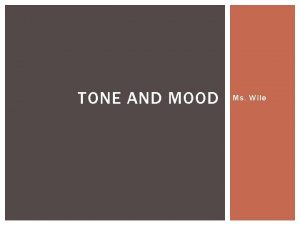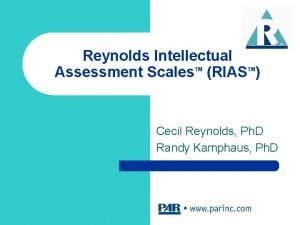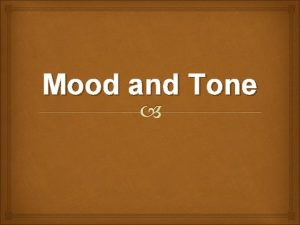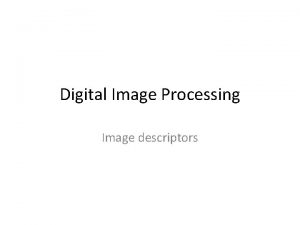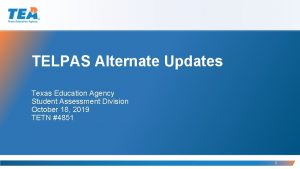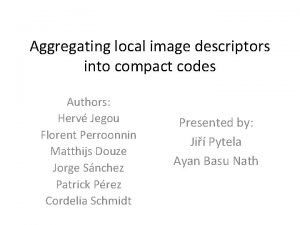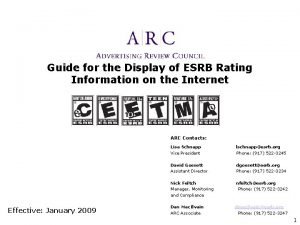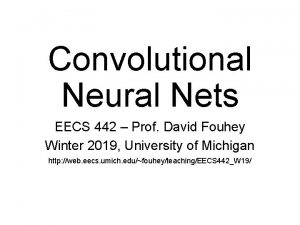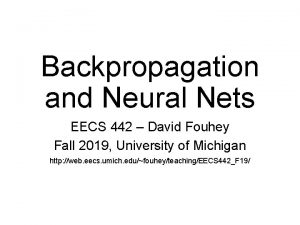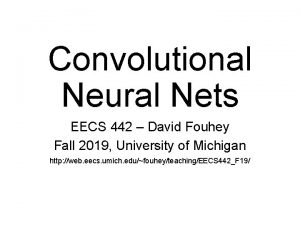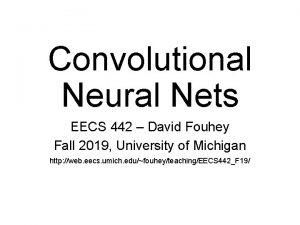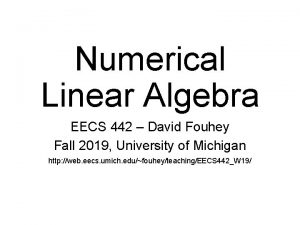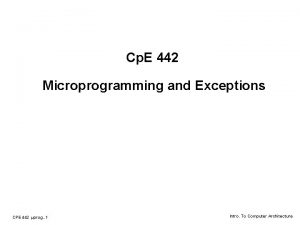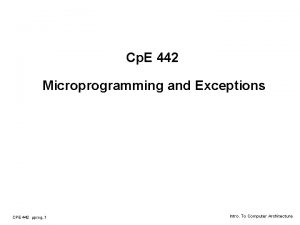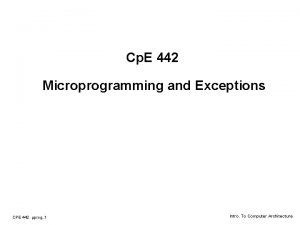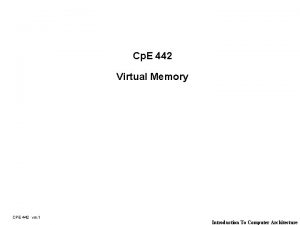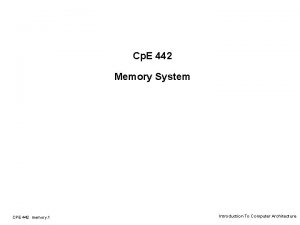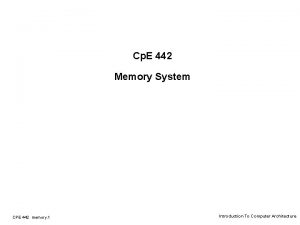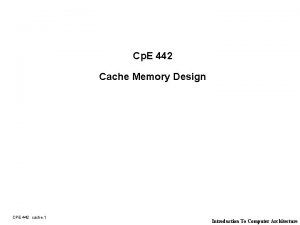Detectors and Descriptors EECS 442 Prof David Fouhey






































![Noise in 2 D Noisy Input Ix via [-1, 01] Zoom Noise in 2 D Noisy Input Ix via [-1, 01] Zoom](https://slidetodoc.com/presentation_image_h/e5ecb5d035561061e3691c85e20002ac/image-39.jpg)
![Noise + Smoothing Smoothed Input Ix via [-1, 01] Zoom Noise + Smoothing Smoothed Input Ix via [-1, 01] Zoom](https://slidetodoc.com/presentation_image_h/e5ecb5d035561061e3691c85e20002ac/image-40.jpg)













![Formalizing Corner Detection Can compute E[u, v] for any window and u, v. But Formalizing Corner Detection Can compute E[u, v] for any window and u, v. But](https://slidetodoc.com/presentation_image_h/e5ecb5d035561061e3691c85e20002ac/image-54.jpg)




![Review: Quadratic Forms Suppose have symmetric matrix M, scalar a, vector [u, v]: Then Review: Quadratic Forms Suppose have symmetric matrix M, scalar a, vector [u, v]: Then](https://slidetodoc.com/presentation_image_h/e5ecb5d035561061e3691c85e20002ac/image-59.jpg)


























- Slides: 85

Detectors and Descriptors EECS 442 – Prof. David Fouhey Winter 2019, University of Michigan http: //web. eecs. umich. edu/~fouhey/teaching/EECS 442_W 19/

Administrivia • Today/Thursday: Detecting edges and corners in images and describing them • Discussion Section: reviewing projection and convolution. • If you have accommodation needs or need an alternate midterm, please email me this week. • Please do not schedule stuff for the class that is listed as the midterm going forward.

General Hints for Vision Debugging • Visualize • Break it into bite-sized chunks; verify each • Test the smallest version possible • Use a debugger (pdb or use the jupyter cells) • Try explaining your code verbally

Goal How big is this image as a vector? 389 x 600 = 233, 400 dimensions (big)

Applications To Have In Mind Part of the same photo? Same computer from another angle?

Applications To Have In Mind Building a 3 D Reconstruction Out Of Images Slide Credit: N. Seitz

Applications To Have In Mind Stitching photos taken at different angles

One Familiar Example Given two images: how do you align them?

One (Hopefully Familiar) Solution for y in range(-y. Search, y. Search+1): for x in range(-x. Search, x. Search+1): #Touches all Hx. W pixels! check_alignment_with_images()

One Motivating Example Given these images: how do you align them? These aren’t off by a small 2 D translation but instead by a 3 D rotation + translation of the camera. Photo credit: M. Brown, D. Lowe

One (Hopefully Familiar) Solution for y in y. Range: for x in x. Range: for z in z. Range: for x. Rot in x. Rot. Vals: for y. Rot in y. Rot. Vals: for z. Rot in z. Rot. Vals: #touches all Hx. W pixels! check_alignment_with_images() This code should make you really unhappy Note: this actually isn’t even the full number of parameters; it’s actually 8 for loops.

An Alternate Approach Given these images: how would you align them? A mountain peak! This dark spot

An Alternate Approach Finding and Matching 1: find corners+features 2: match based on local image data Slide Credit: S. Lazebnik, original figure: M. Brown, D. Lowe

What Now? Given pairs p 1, p 2 of correspondence, how do I align? Consider translationonly case from HW 1.

An Alternate Approach Solving for a Transformation T 3: Solve for transformation T (e. g. such that p 1 ≡ T p 2) that fits the matches well Note the homogeneous coordinates, you’ll see them again. Slide Credit: S. Lazebnik, original figure: M. Brown, D. Lowe

An Alternate Approach Blend Them Together Key insight: we don’t work with full image. We work with only parts of the image. Photo Credit: M. Brown, D. Lowe

Today Finding edges (part 1) and corners (part 2) in images. Corner of the glasses Edge next to panel

Where do Edges Come From?

Where do Edges Come From? Depth / Distance Discontinuity Why?

Where do Edges Come From? Surface Normal / Orientation Discontinuity Why?

Where do Edges Come From? Surface Color / Reflectance Properties Discontinuity

Where do Edges Come From? Illumination Discontinuity

Last Time -1 0 Ix 1 -1 0 Iy 1 T

Last Time (Ix 2 + Iy 2 )1/2

Why Does This Work? Image is function f(x, y) Remember: Approximate: 1 -1 Another one: -1 0 1

Other Differentiation Operations Horizontal Vertical Prewitt Sobel Why might people use these compared to [-1, 0, 1]?

Review: Gradients Gradient is just the collection of partial derivatives in each dimension/direction. Points in direction that increases the most. How much f changes in the direction of x 1 at point a.

Images as Functions or Points Key idea: can treat image as a point in R(Hx. W) or as a function of x, y. How much the intensity of the image changes as you go horizontally at (x, y) (Often called Ix)

Image Gradient Direction Some gradients Figure Credit: S. Seitz

Image Gradient: direction of maximum change. What’s the relationship to edge direction? Ix Iy

Image Gradient (Ix 2 + Iy 2 )1/2 : magnitude

Image Gradient atan 2(Iy, Ix): orientation I’m making the lightness equal to gradient magnitude

Image Gradient atan 2(Iy, Ix): orientation Now I’m showing all the gradients

Image Gradient atan 2(Iy, Ix): orientation Why is there structure at 1 and not at 2? 1 2

Noise Consider a row of f(x, y) (i. e. , fix y) Slide Credit: S. Seitz

Noise Conv. image + per-pixel noise with True image -1 0 1 True difference Sum of 2 Gaussians Variance doubles!

Noise Consider a row of f(x, y) (i. e. , make y constant) How can we use the last class to fix this? Slide Credit: S. Seitz

Handling Noise f g f*g Slide Credit: S. Seitz
![Noise in 2 D Noisy Input Ix via 1 01 Zoom Noise in 2 D Noisy Input Ix via [-1, 01] Zoom](https://slidetodoc.com/presentation_image_h/e5ecb5d035561061e3691c85e20002ac/image-39.jpg)
Noise in 2 D Noisy Input Ix via [-1, 01] Zoom
![Noise Smoothing Smoothed Input Ix via 1 01 Zoom Noise + Smoothing Smoothed Input Ix via [-1, 01] Zoom](https://slidetodoc.com/presentation_image_h/e5ecb5d035561061e3691c85e20002ac/image-40.jpg)
Noise + Smoothing Smoothed Input Ix via [-1, 01] Zoom

Let’s Make It One Pass (1 D) f Slide Credit: S. Seitz

Let’s Make It One Pass (2 D) Gaussian Derivative Filter Which one finds the X direction? Slide Credit: L. Lazebnik

Applying the Gaussian Derivative 1 pixel 3 pixels 7 pixels Removes noise, but blurs edge Slide Credit: D. Forsyth

Compared with the Past Gaussian Derivative Sobel Filter Why would anybody use the bottom filter?

Filters We’ve Seen Smoothing Derivative Example Gaussian Deriv. of gauss Goal Remove noise Find edges Only +? Yes No Sums to 1 0 Why sum to 1 or 0, intuitively? Slide Credit: J. Deng

Problems Image human segmentation gradient magnitude Still an active area of research

Corners 9300 Harris Corners Pkwy, Charlotte, NC Slide Credit: S. Lazebnik

Desirables • Repeatable: should find same things even with distortion • Saliency: each feature should be distinctive • Compactness: shouldn’t just be all the pixels • Locality: should only depend on local image data Property list: S. Lazebnik

Example Can you find the correspondences? Slide credit: N. Snavely

Example Matches Look for the colored squares Slide credit: N. Snavely

Basic Idea Should see where we are based on small window, or any shift → big intensity change. “flat” region: no change in all directions Slide Credit: S. Lazebnik “edge”: no change along the edge direction “corner”: significant change in all directions

Formalizing Corner Detection Sum of squared differences between image and image shifted u, v pixels over. Image I(x, y) Plot of E(u, v) E(3, 2) Slide Credit: S. Lazebnik

Formalizing Corner Detection Sum of squared differences between image and image shifted u, v pixels over. Image I(x, y) Plot of E(u, v) E(0, 0) What’s the value of E(0, 0)? Slide Credit: S. Lazebnik
![Formalizing Corner Detection Can compute Eu v for any window and u v But Formalizing Corner Detection Can compute E[u, v] for any window and u, v. But](https://slidetodoc.com/presentation_image_h/e5ecb5d035561061e3691c85e20002ac/image-54.jpg)
Formalizing Corner Detection Can compute E[u, v] for any window and u, v. But we’d like an simpler function of u, v. Slide Credit: S. Lazebnik

Aside: Taylor Series for Images Recall Taylor Series: Do the same with images, treating them as function of x, y

Formalizing Corner Detection Taylor series expansion for I at every single point in window Cancel Expand For brevity: Ix = Ix at point (x, y), Iy = Iy at point (x, y)

Formalizing corner Detection By linearizing image, we can approximate E(u, v) with quadratic function of u and v M is called the second moment matrix

Intuitively what is M? Pretend for now gradients are either vertical or horizontal at a pixel (so Ix Iy = 0) Obviously Wrong! If a, b are both small: flat If one is big, one is small: edge If a, b both big: corner
![Review Quadratic Forms Suppose have symmetric matrix M scalar a vector u v Then Review: Quadratic Forms Suppose have symmetric matrix M, scalar a, vector [u, v]: Then](https://slidetodoc.com/presentation_image_h/e5ecb5d035561061e3691c85e20002ac/image-59.jpg)
Review: Quadratic Forms Suppose have symmetric matrix M, scalar a, vector [u, v]: Then the isocontour / slice-through of F, i. e. is an ellipse. Diagram credit: S. Lazebnik

Review: Quadratic Forms We can look at the shape of this ellipse by decomposing M into a rotation + scaling What are λ 1 and λ 2? direction of the fastest change direction of the slowest change ( 1)-1/2 Slide credit: S. Lazebnik ( 2)-1/2

Interpreting The Matrix M The second moment matrix tells us how quickly the image changes and in which directions. Can compute at each pixel Directions Amounts

Visualizing M Slide credit: S. Lazebnik

Visualizing M Slide credit: S. Lazebnik

Interpreting Eigenvalues of M 2 “Edge” 2 >> 1 “Corner” 1 and 2 are large, 1 ~ 2; E increases in all directions 1 and 2 are small; E is almost constant in all directions “Flat” region “Edge” 1 >> 2 1 Slide credit: S. Lazebnik

Putting Together The Eigenvalues “Edge” R<0 “Corner” R>0 α: constant (0. 04 to 0. 06) |R| small “Flat” region Slide credit: S. Lazebnik “Edge” R<0

In Practice 1. Compute partial derivatives Ix, Iy per pixel 2. Compute M at each pixel, using Gaussian weighting w C. Harris and M. Stephens. “A Combined Corner and Edge Detector. ” Proceedings of the 4 th Alvey Vision Conference: pages 147— 151, 1988. Slide credit: S. Lazebnik

In Practice 1. Compute partial derivatives Ix, Iy per pixel 2. Compute M at each pixel, using Gaussian weighting w 3. Compute response function R C. Harris and M. Stephens. “A Combined Corner and Edge Detector. ” Proceedings of the 4 th Alvey Vision Conference: pages 147— 151, 1988. Slide credit: S. Lazebnik

Computing R Slide credit: S. Lazebnik

Computing R Slide credit: S. Lazebnik

In Practice 1. Compute partial derivatives Ix, Iy per pixel 2. Compute M at each pixel, using Gaussian weighting w 3. Compute response function R 4. Threshold R C. Harris and M. Stephens. “A Combined Corner and Edge Detector. ” Proceedings of the 4 th Alvey Vision Conference: pages 147— 151, 1988. Slide credit: S. Lazebnik

Thresholded R Slide credit: S. Lazebnik

In Practice 1. Compute partial derivatives Ix, Iy per pixel 2. Compute M at each pixel, using Gaussian weighting w 3. Compute response function R 4. Threshold R 5. Take only local maxima (called non-maxima suppression) C. Harris and M. Stephens. “A Combined Corner and Edge Detector. ” Proceedings of the 4 th Alvey Vision Conference: pages 147— 151, 1988. Slide credit: S. Lazebnik

Thresholded, NMS R Slide credit: S. Lazebnik

Final Results Slide credit: S. Lazebnik

Desirable Properties If our detectors are repeatable, they should be: • Invariant to some things: image is transformed and corners remain the same • Covariant/equivariant with some things: image is transformed and corners transform with it. Slide credit: S. Lazebnik

Recall Motivating Problem Images may be different in lighting and geometry

Affine Intensity Change M only depends on derivatives, so b is irrelevant But a scales derivatives and there’s a threshold R R threshold x (image coordinate) Partially invariant to affine intensity changes Slide credit: S. Lazebnik

Image Translation All done with convolution. Convolution is translation invariant. Equivariant with translation Slide credit: S. Lazebnik

Image Rotations just cause the corner rotation to change. Eigenvalues remain the same. Equivariant with rotation

Image Scaling Corner One pixel can become many pixels and vice-versa. Not equivariant with scaling

Next time • Fixing this scaling issue • Describing the corners


Desirable Properties Repeatable: we can find the same place even after photometric and geometric distortion.

Desirable Properties Compactness: we don’t just use all the pixels Saliency: the place is distinctive

Desirable Properties Locality: the feature doesn’t depend on the whole image but instead some part
 David fouhey
David fouhey Caturana
Caturana David fouhey
David fouhey David fouhey
David fouhey Eecs 442
Eecs 442 Eecs 442
Eecs 442 Where are feature detectors located
Where are feature detectors located Feature detectors ap psychology
Feature detectors ap psychology Feature vectors
Feature vectors Feature detectors
Feature detectors Frontier detectors for frontier physics
Frontier detectors for frontier physics Yodsawalai chodpathumwan
Yodsawalai chodpathumwan Photo detectors
Photo detectors What is streaming potential
What is streaming potential Vhv voltage detectors
Vhv voltage detectors Photo detectors
Photo detectors Nuclear detectors
Nuclear detectors Which detector used in hplc
Which detector used in hplc Giant wave detectors murmurs universe
Giant wave detectors murmurs universe Gravitational wave detectors hear murmurs from
Gravitational wave detectors hear murmurs from Lesson preparation siop
Lesson preparation siop Comp 442
Comp 442 Compiler design tutorial
Compiler design tutorial Psalm 73 liedboek
Psalm 73 liedboek Power electronics
Power electronics Ece 442
Ece 442 442 media
442 media Ee 442
Ee 442 Ece 442
Ece 442 Ece 442
Ece 442 Comp 442
Comp 442 Ece 442 çankaya
Ece 442 çankaya Me 442
Me 442 Me 442
Me 442 Controlece
Controlece Stat 442
Stat 442 Comp 442
Comp 442 Round 442 to the nearest ten
Round 442 to the nearest ten Smart table 442i
Smart table 442i California swimming pool safety act 1998
California swimming pool safety act 1998 Ece 442
Ece 442 Compiler
Compiler Cs 442
Cs 442 Prof david toback
Prof david toback Prof david kipping
Prof david kipping Initial grade to final grade
Initial grade to final grade Veyldf learning and development outcome descriptors
Veyldf learning and development outcome descriptors Anatomic descriptors and fundamental body structure
Anatomic descriptors and fundamental body structure Segment descriptor
Segment descriptor Epostl descriptors
Epostl descriptors Tone vs mood
Tone vs mood Mood descriptors
Mood descriptors Mood descriptors
Mood descriptors Slidetodoc.com
Slidetodoc.com Rias assessment
Rias assessment Image representation and description
Image representation and description The author’s tone gives the mood of _______.
The author’s tone gives the mood of _______. File descriptors
File descriptors Wais qualitative descriptors
Wais qualitative descriptors Verbal descriptors in grading system
Verbal descriptors in grading system Epostl descriptors
Epostl descriptors What are the 4 elpac levels?
What are the 4 elpac levels? Wida can do descriptors
Wida can do descriptors Representation and description in image processing
Representation and description in image processing Boundary representation in digital image processing
Boundary representation in digital image processing Likert scale descriptors
Likert scale descriptors Marketing research measurement scales
Marketing research measurement scales Authors tone
Authors tone Low inference descriptors
Low inference descriptors Ljmu grade descriptors
Ljmu grade descriptors Ljmu grade descriptors
Ljmu grade descriptors Mental status examination
Mental status examination Telpas alt observable behaviors
Telpas alt observable behaviors Elps texas
Elps texas Msfd descriptors
Msfd descriptors Msfd descriptors
Msfd descriptors Brunel university grade boundaries
Brunel university grade boundaries Msfd descriptors
Msfd descriptors Aggregating local image descriptors into compact codes
Aggregating local image descriptors into compact codes Companion volume with new descriptors
Companion volume with new descriptors Mood descriptors in play
Mood descriptors in play Mood descriptors in play
Mood descriptors in play Fsa achievement level descriptors 2020
Fsa achievement level descriptors 2020 Content descriptors
Content descriptors Esrb content descriptors
Esrb content descriptors What does wida stand for
What does wida stand for


